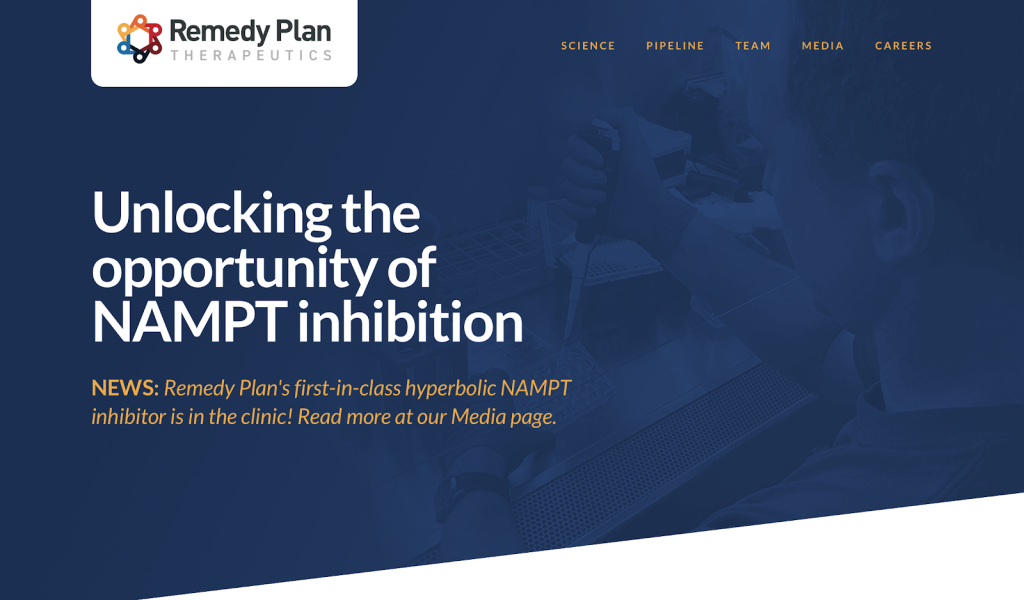Remedy Plan Therapeutics Secures $18M to Advance First-in-Class Hyperbolic NAMPT Inhibitors
July 14, 2025
byFenoms Startup Research

Remedy Plan Therapeutics, a pioneering biotech company focused on next-generation cancer treatments, has successfully raised $18 million in funding to accelerate clinical development of its flagship hyperbolic NAMPT inhibitor therapy. This major investment marks a critical inflection point for the startup, which is now poised to push its lead candidate through clinical trials with the potential to disrupt the oncology space.
Investors Backing a Breakthrough Vision
The funding round was led by Schooner Capital, with significant participation from Alexandria Venture Investments and other existing investors. This financial backing not only validates the science behind Remedy Plan’s work but also underscores the growing interest in metabolic oncology, a niche that’s gaining momentum as researchers unlock new strategies to starve tumors of energy and survival signals.
CEO Gregory Crimmins continues to steer the company with strategic clarity, combining a deep understanding of molecular biology with a mission-driven approach to patient outcomes. With this capital injection, Remedy Plan now has the resources to expand its clinical program and bring a revolutionary approach to cancer therapy closer to market.
What Remedy Plan Is Solving
At the heart of Remedy Plan’s innovation is its focus on NAMPT inhibition - a critical target in cancer cell metabolism. NAMPT (nicotinamide phosphoribosyltransferase) is a key enzyme that helps cancer cells maintain their energy balance by regulating NAD+ production. By selectively inhibiting NAMPT, Remedy Plan’s compounds can effectively cut off this supply chain, pushing tumors into metabolic collapse without harming healthy cells.
What sets Remedy Plan apart is its creation of a first-in-class hyperbolic NAMPT inhibitor - a molecule that binds with increased potency as NAD+ levels decrease, providing a dynamic feedback loop that enhances therapeutic selectivity and efficacy.
This approach could solve a long-standing challenge in cancer therapy: how to kill tumor cells without overwhelming toxicity. If successful, it opens the door to a new category of precision metabolic treatments - ones that hit the tumor where it’s metabolically weakest.
Why It Matters Now
As the oncology landscape evolves, metabolic targets like NAMPT are gaining serious traction. Traditional approaches such as chemotherapy and kinase inhibitors often suffer from acquired resistance and systemic side effects. Remedy Plan is part of a new wave of targeted therapies that disrupt tumor metabolism, an area that has drawn significant attention from both pharma and VC firms.
A key insight for biotech founders: Targeting metabolic vulnerabilities in cancer offers a broad therapeutic window without compromising safety, especially when you can selectively modulate targets like NAMPT with next-gen molecules. The potential isn't just in developing drugs - it’s in owning the logic of adaptive biology, where therapy dynamically responds to the tumor’s changing state.
This delivers a powerful insight for founders across biotech: therapies that align with dynamic biological states - rather than bluntly override them - scale faster, fail less often in trials, and adapt better to patient variability. It’s not about building the most potent blocker; it’s about designing therapies that evolve with the system. Biology is a moving target, and the next wave of clinical success will come from platforms that adapt in real time.
This feedback-based mechanism - hyperbolic inhibition - is a major scientific leap. It’s not just about blocking an enzyme; it’s about leveraging biology’s internal wiring to intensify therapeutic impact as the disease progresses. That kind of model-based innovation is where the next generation of biotech winners will be built.
The Rise of Metabolic Oncology
The metabolic oncology market is experiencing rapid growth, driven by advances in single-cell analysis, precision medicine, and deeper understanding of cancer’s reliance on specific nutrient pathways. According to Research and Markets, the global cancer metabolism-based therapeutics market is expected to surpass $5.3 billion by 2030, with NAMPT, IDH, and glutaminase among the most heavily studied targets.
Moreover, over 40% of all cancer types exhibit upregulated NAMPT expression, making it a highly viable target across multiple indications including breast, colorectal, lung, and pancreatic cancers. Despite previous attempts to inhibit NAMPT falling short due to toxicity and lack of specificity, Remedy Plan’s hyperbolic mechanism could be the breakthrough that reopens this high-potential target with a safer clinical profile.
The biotech industry is watching closely. If Remedy Plan’s compound can demonstrate tolerability and tumor selectivity in clinical trials, it could represent a paradigm shift in how metabolic cancer therapies are designed and delivered.
Gregory Crimmins: Driving Innovation with Scientific Rigor
Under the leadership of Gregory Crimmins, Remedy Plan has moved with strategic precision. Crimmins, who holds a Ph.D. in Molecular and Cell Biology, has been relentless in his pursuit of translational science - bridging the gap between promising research and real patient outcomes. His vision is grounded in one belief: biotech innovation must match biological complexity with equally adaptive tools.
This belief is reflected in the company’s approach to drug development, which emphasizes mechanistic modeling, rigorous preclinical validation, and tight alignment with unmet clinical needs. Remedy Plan is not chasing trends - it’s carving out a new lane for next-generation metabolic therapeutics.
What’s Next for Remedy Plan Therapeutics
With this new $18 million infusion, Remedy Plan plans to:
- Advance its lead NAMPT inhibitor into Phase 1 clinical trials
- Expand its research team to deepen its metabolic oncology pipeline
- Establish strategic partnerships with academic and pharma collaborators
- Enhance its biomarker platform to identify responsive patient subgroups
As the biotech world looks for the next breakthrough in targeted therapy, all eyes are on the Remedy Plan. Their science is bold, their vision is clear, and their timing - backed by funding and data - is impeccable.









